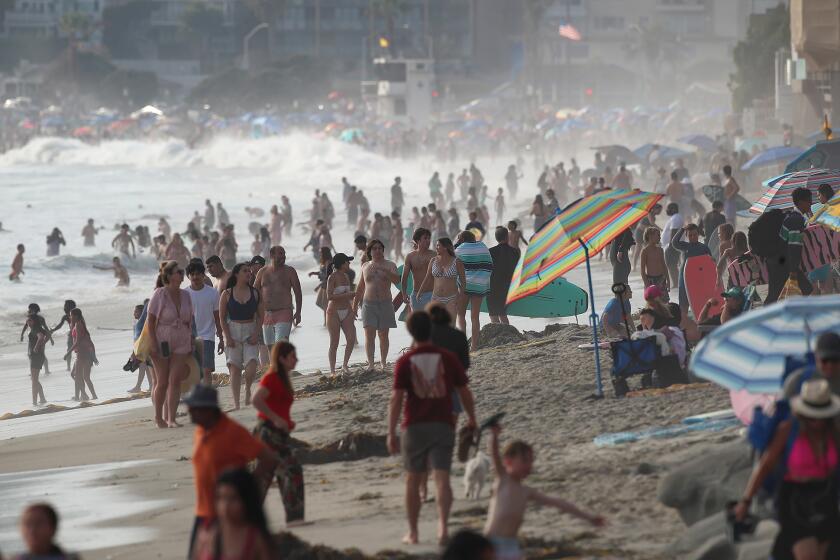Mighty midgets of Talbert’s Carrot Patch
- Share via
A LOOK BACK
There was this story that my friend Rusty Shepard used to tell of
the time he had convinced an engineer at Hughes Aircraft that when it
rained hard in Huntington Beach the water would fill up the racetrack
so much that boat races where held around its track.
After one heavy storm, this fellow drove down here to watch them
and that was when he learned what Rusty told him was just a good old
joke.
But Rusty’s racetrack was no joke. In April of 1946 Charles
Borchard and the W.T. Newland estate sold 60 acres south of Atlanta
Avenue and west of Beach Boulevard to William Iverson. He in turn
sold the land to Tom Talbert, and this area became known as
“Talbert’s Carrot Patch.”
But Talbert had other uses in store for the land. Two promoters,
Bob Ware and Harold Mathewson, convinced Talbert that a midget car
racetrack would be the perfect use for his property. But bad luck
would haunt this venture from the very start. The racetrack would be
a fifth of a mile oval track and would be patterned after Gilmore
stadium in Hollywood. The lumber to build the stadium was delivered
to the site, but before construction could start, a federal
government agency stepped in and confiscated the lumber for housing.
So the grandstand had to be “scooped” out of a nearby field and
fashioned into a mound. This was then covered in a gunite covering to
create a makeshift stadium. As long as it didn’t rain everything
would work fine, but as the opening day approached in November 1946,
the rains came and the opening was postponed.
Again a day was set for the opening and again it had to be
postponed because of rain. On the third try, a date of Dec. 8 was
selected for the midget cars to race around the track. The stadium
was built to seat 17,000 fans, cost $200,000 to build and would be
the finest midget car racetrack on the West Coast.
Ware, the promoter, was very familiar with these tracks, having
raced for more than 25 years.
When Sunday the 8th arrived everything looked like a “go.” The
Huntington Beach Speedway, as the stadium was called, drew 3,500
people to watch the inaugural races. In car No. 44, Jerry Piper from
Oakland won the main 20-lap event with a time of 4:50:61, and Claude
Herrick won the 15-lap race on the dirt track.
During the third lap of the 15-lap race, two of the midget racers
piled up in the turn and then two more piled into them and a fifth
midget car driven by “Frenchy” Geitz hit a guard rail and flew 15
feet into the air.
It was luck that none of the drivers were hurt, but that can’t be
said of their cars. On the next Sunday, Dec. 15, Ware and Mathewson
decided that last week’s race was an informal one and this race would
be their official opening race.
Racing that day were Russ Fields, Bill Zaring, Billy & Eli
Vukovich, Dan Farmer and Bill Breton. Stan Searl won the main race
against Bob Pankratz.
You have to remember that after World War II the midget racer were
a popular type of outdoor entertainment for people and our speedway
brought many of these champion drivers to our city.
Midget races remained popular throughout the late 1940s, and the
Huntington Beach Speedway had its highest attendance on July 3, 1947,
when 14,000 fans paid to watch the races and thousands more had to be
turned away.
By 1950, television came onto the scene and people stayed home to
watch the little screen. Winter rains began damaging the stand. But
the top drivers still kept coming to our track, with familiar names
such as Troy Ruttman, Andy Linden, Johnny Parsons, Pat Flaherty, Don
Freeman and Harry Stockman.
Huntington Beach resident Art Hermann remembers his favorite
driver, Roy Prosser at the stadium. During the first year, the track
was paved, and motorcycles were raced around its oval course.
Familiar motorcyclists like Pee Wee Cullun, Jimmy Gibbs, Cordy Milne,
Ed Hinkle, Floyd Emde and Tom Banford all raced here.
To keep people coming in, Model T Fords played auto polo for
laughs on the infield. Wild West shows were staged, and sports car
races were held, too. The American Legion Post #133 held jalopy races
there each summer.
But the stadium’s days were numbered. Attendance began to drop,
and rain damage rapidly deteriorated the structures to the point that
the land’s owner, Talbert closed the speedway in May of 1958.
During its brief 12 years, the stadium was known as the Huntington
Beach Speedway, Talbert Stadium, Huntington Beach Stadium and in 1958
as the American Legion Stadium.
Talbert’s Carrot Patch is no more, but in those few short years
put Huntington Beach on the racing map. Our residents had a chance to
watch those mighty midgets race round and around our own speedway.
* JERRY PERSON is a local historian and longtime Huntington
Beach resident. If you have ideas for future columns, write him at
P.O. Box 7182, Huntington Beach, CA 92615.
All the latest on Orange County from Orange County.
Get our free TimesOC newsletter.
You may occasionally receive promotional content from the Daily Pilot.



